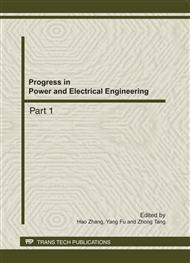p.222
p.226
p.231
p.236
p.240
p.246
p.251
p.256
p.269
Experiment and Thermodynamic Analysis on Mineral Formation of Cement Clinker Cogeneration from Coal in Pulverized Coal Combustion Boiler
Abstract:
Take Changguang high-sulfur coal as experimental coal type; carry out the experiment of mineral formation rule of co-generation cement clicker on two-section multiphase reaction test stand and conduct XRD, SEM and EDS analyses on the mineral composition of the obtained co-generation clicker sample. It can be found from the experimental results that the mineral composition of co-generation clinker presents great difference with the temperature change in the furnace on the test stand; when the temperature in the furnace reaches to 1,330°C, the main mineral species in co-generation clinker sample are 2CaO•SiO2, Q phase and 3CaO•3Al2O3•CaSO4 with excellent hydration activity. Conducted thermodynamic calculation on the mineral formation reaction probably occurring in the chemical compositions of Q-phase cement clinker co-generated from Changguang coal. It is shown in the findings of computational analyses that, according to the chemical composition of clinker, the direct synthesis reaction of 2CaO•Al2O3•SiO2 firstly occurs, followed by the direct synthesis reaction of 2CaO•SiO2, the next is the indirect synthesis reaction of Q-phase mineral, and the last is the indirect synthetic reaction of 3CaO•3Al2 O3•CaSO4; the final main mineral compositions of co-generation clinker should be 2CaO•SiO2, Q phase and 3CaO•3Al2O3•CaSO4. The conclusion of thermodynamic analyses on co-generation clicker mineral formation reaction basically conforms to the mineral composition in experiment of Changguang coal co-generating Q-phase cement clinker.
Info:
Periodical:
Pages:
240-245
Citation:
Online since:
October 2011
Authors:
Price:
Сopyright:
© 2012 Trans Tech Publications Ltd. All Rights Reserved
Share:
Citation:


